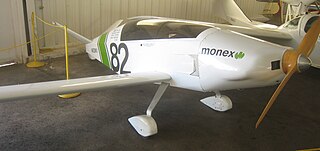
The Onex, Sonex, Waiex and Xenos are a family of lightweight, metal, low-wing, two seat homebuilt aircraft. Kits are produced and marketed by Sonex Aircraft, a small manufacturer based in Oshkosh, Wisconsin. By 2014, 500 customer built aircraft had been completed. The Sonex can also be built from plans.

The Monnett Moni is a sport aircraft developed in the United States in the early 1980s and marketed for homebuilding.

The Thatcher CX4 is an American-designed aircraft for amateur construction designed by David Thatcher of Pensacola, Florida and plans are supplied by Thatcher Aircraft, Inc.

The Zenair Tri-Z CH 300 is a three-seat Canadian homebuilt light aircraft. A single-engined low-winged monoplane, the CH 300 first flew in 1977, with several hundred kits sold.

The Monnett Monex is a single seat, all-aluminium, Volkswagen powered, homebuilt racer.
The Monnett Mini, also called the Mini Messashidt, was an early John Monnett modification of the Parker Jeanies Teenie.

The Aero-Kros MP-02 Czajka is a Polish ultralight aircraft designed and developed by Aero-Kros of Krosno, introduced at the Aero show held in Friedrichshafen in 2009. The aircraft is supplied ready-to-fly.

The Alpi Pioneer 300 is an Italian ultralight and light-sport aircraft, designed and produced by Alpi Aviation, of Pordenone. The aircraft is supplied as a kit for amateur construction.
The Arplast Micro'B is a French ultralight aircraft that was designed and produced by propeller manufacturer Arplast Helice. It was supplied as a kit for amateur construction or as a complete ready-to-fly-aircraft.

The VL-3 Evolution also called the Aveko VL-3 Sprint is a Czech ultralight aircraft, designed and initially produced by Aveko of Brno. The design is now produced by JMB Aircraft of Choceň. The aircraft was originally supplied by Aveko complete ready-to-fly, but is now owner-completed through a factory assistance program.
The Egvoyager Voyager 203 is an Italian ultralight aircraft, designed and produced by Egvoyager and introduced in May 2011. The aircraft is supplied as a kit for amateur construction or as a complete ready-to-fly aircraft.

The Flaeming Air FA 04 Peregrine is a German ultralight and light-sport aircraft, designed and produced by Flaeming Air of Zellendorf, Brandenburg. The aircraft is supplied as a complete ready-to-fly-aircraft.

The SubSonex is an experimental, single-seat, amateur-built jet aircraft from Sonex Aircraft's "Hornet's Nest" development division.

The Fly Synthesis Syncro is an Italian ultralight and light-sport aircraft, designed and produced by Fly Synthesis, introduced at the Aero show held in Friedrichshafen in 2009. The aircraft is supplied as a complete ready-to-fly-aircraft.

The Sport Performance Aviation Panther is a single seat, all-metal, homebuilt aircraft under development by Sport Performance Aviation of Green Cove Springs, Florida. The aircraft is intended to be supplied as plans and as a kit for amateur construction.

The Roland Z-602 is a German ultralight and light-sport aircraft, produced by Roland Aircraft of Mendig. The aircraft is supplied as a kit for amateur construction or as a complete ready-to-fly-aircraft.

The Spacek SD-1 Minisport is a Czech amateur-built aircraft, designed by Igor Špaček and produced by Spacek of Hodonín. The aircraft was also produced for a short time in the United States by SkyCraft Airplanes of Orem, Utah as a light-sport aircraft, but they had gone out of businesses by 2017. The aircraft is supplied in the form of plans, as a kit for amateur construction, or as a ready-to-fly aircraft.

The Hummel Ultracruiser is an American amateur-built aircraft, designed by Morry Hummel and produced by Hummel Aviation. The aircraft is supplied as a kit or plans for amateur construction or as a complete ready-to-fly aircraft.

The BK Fliers BK-1 is a single seat homebuilt aircraft.
The Direct Fly ArGO is a Czech ultralight and light-sport aircraft, designed and produced by Direct Fly sro of Hluk, introduced at the Blois fly-in show in France, in 2011. When it was available the aircraft was supplied complete and ready-to-fly.





















